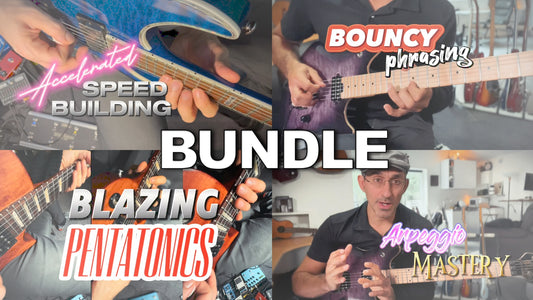How I Turned My Fender Blues Junior Into a High-Gain Machine
Share
If you’ve ever wondered whether a tiny clean amp like the Fender Blues Junior could deliver crushing high-gain tones... well, it can. And I’ll show you exactly how I made it happen using only my pedalboard.
It all started when my main amp - the Mesa Boogie Mark V Combo that I’ve used for over 15 years - had to be sent overseas for repairs. That’s when I picked up a Fender Blues Junior. A basic tube amp. No FX loop, no bells and whistles. But I had an idea: what if I let my pedalboard handle all the heavy lifting?
Here’s the full rundown of how I turned it into a high-gain monster.
My Pedalboard Setup - The Preamp in a Box
The signal chain starts with a tuner, then goes into a noise suppressor. I use the four-cable method to loop all the noisy pedals through the suppressor. When I’m not playing, everything is dead silent - no hiss, no hum.
Then comes my “preamp” chain, where all the high-gain magic happens:
- Ibanez Tube Screamer: Tightens the low end and adds that signature mid-hump. It’s subtle but essential for that percussive, modern rhythm tone.
- Wampler Ego Compressor: Adds warmth and Mojo through parallel compression. I blend it in carefully - just enough to get punch without sacrificing tightness.
- MXR Dyna Comp (red box): Adds a clear attack to every note. Not used for compression here, just for that front-end punch.
- Friedman BE-OD: This is the main distortion engine. It’s my high-gain channel in a box, and it sounds massive.
- MXR 10-Band EQ: After the distortion, this lets me scoop mids and boost lows and highs for that classic V-shaped metal tone.
Together, these pedals simulate a full-blown high-gain amp head feeding a cabinet. And it works. Beautifully.
Time-Based Effects & Amp Integration
Because the Blues Junior doesn’t have an effects loop, I run delay and reverb pedals after all gain stages. I keep the reverb subtle - especially for rhythm playing. If I were mixing this in a full production, I might skip reverb entirely, but for the feel and vibe of solo videos, it helps.
The amp itself? Nothing fancy. Clean channel, no reverb, fat switch off. Volume set low to maintain headroom and let the pedals breathe. I’m not slamming the amp - I’m letting the pedals shape the tone entirely.
Speaker, Micing & Cabinet Simulation
The speaker setup is a bit unconventional. I’m running the Blues Junior into a power attenuator, and from there into the cabinet of my Mesa Boogie Mark V (which is currently headless). This gives me the darker, low-end-rich tone I prefer compared to the stock Jensen speaker.
For micing, I use an SM57 pointed at the Mesa cab, blended with a More IR cabinet simulator. Sometimes I’ll use an AKG mic too, but for this tone, the 57 plus IR does the job.
Mic-only gives you the classic midrange punch. IR-only gives you a roomier, low-end-heavy feel. Blending the two is the key to a flexible, powerful sound. You don’t need a boutique cab to make this work - you just need creativity and control over each element.
Final Thoughts
I never would’ve discovered this setup if my Mesa hadn’t gone down. But now that I’ve tried it, I love it. The pedalboard becomes the brain - the amp is just a clean power platform. And it shows that you don’t always need to spend thousands on a high-end tube head. Sometimes a humble Blues Junior is all you need.
Got questions about specific pedals or parts of the rig? Let me know and I’ll dive deeper in a future video.
Stay loud - Kris



